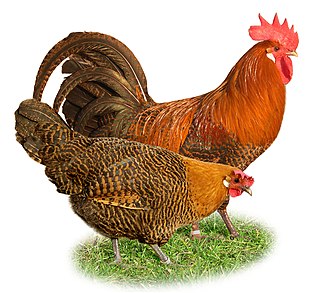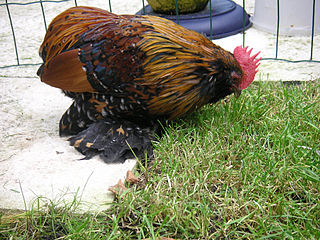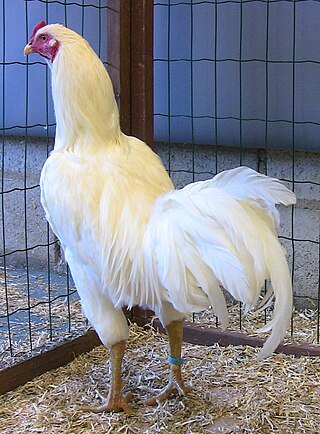
The American Game is an American breed of game fowl, chickens bred specifically for cockfighting. It has many color varieties, and may also be kept for ornament.

The Braekel or Brakel is a traditional Belgian breed of chicken. It is thought to have originated in the area of Brakel, in the Flemish province of East Flanders, for which it is named. There is a bantam version of the Braekel. The Campine of the United Kingdom derives from it.

The Cochin is a breed of large domestic chicken. It derives from large feather-legged chickens brought from China to Europe and North America in the 1840s and 1850s. It is reared principally for exhibition. It was formerly known as Cochin-China.

The Indian Game is a British breed of game chicken, now reared either for meat or show. It originated in the early nineteenth century in the counties of Cornwall and Devon in south-west England. It is a heavy, muscular bird with an unusually broad breast; the eggs are brown.

The Malay Game is a breed of game chicken. It is among the tallest breeds of chicken, and may stand over 90 cm high.

The Old English Game is a British breed of domestic chicken. It was probably originally bred for cockfighting. Two different standards are recognised by the Poultry Club of Great Britain: Carlisle Old English Game and Oxford Old English Game. There is also an Old English Game bantam.

The Hamburg, Dutch: Hollands hoen, German: Hamburger, is a breed of chicken which is thought to have originated in Holland sometime prior to the fourteenth century. The name may be spelled Hamburgh in the United Kingdom and in Australia.

The New Hampshire Red or New Hampshire is an American breed of chicken. It was developed in the early twentieth century in the state of New Hampshire by selective breeding of Rhode Island Red stock; no other breed was involved. It is fast-growing, early-maturing, quick-feathering, and yields a meaty carcass. Mature birds are a light or medium red in color; they may fade in sunlight.

The Sumatra is a European and North American breed of chicken. It derives from birds imported in the nineteenth century from the island of Sumatra in Indonesia as fighting cocks.

The Appenzeller Spitzhauben is a Swiss breed of crested chicken originating in the historical Appenzell region of Switzerland. It is one of two chicken breeds from that area, the other being the Appenzeller Barthuhn; the only other Swiss breed of chicken is the Schweizer.

The Barbu d'Everberg, is a Belgian breed of bantam chicken. It is a tailless variant of the Barbu d'Uccle, and was bred in about 1906 at the Château d'Everberg, at Everberg in the municipality of Kortenberg, between Brussels and Leuven. It is among the most endangered chicken breeds in Belgium, and in 2010 its conservation status was classed as "critical". It is a true bantam, with no large counterpart. Cocks weigh 700–800 grams, and hens 550–650 g.

The Brabanter is a Dutch breed of crested chicken originating in the historic region of Brabant which straddles Belgium and the Netherlands. It is an ancient breed and is shown in 17th-century paintings. A bantam Brabanter was created in around 1934.

The Asil or Aseel is an Indian breed or group of breeds of game chicken. It is distributed in much of India, particularly in the states of Tamil Nadu, Andhra Pradesh, Chhattisgarh and Odisha; it has been exported to several other countries. Similar fowl are found throughout much of Southeast Asia.

The Schweizer, German: Schweizerhuhn or "Swiss chicken", is a Swiss breed of domestic chicken. It was bred in 1905 in Amriswil, in the canton of Thurgau, in north-east Switzerland. It is kept mainly in German-speaking areas of the country. It is one of three Swiss chicken breeds, the others being the Appenzeller Barthuhn and the Appenzeller Spitzhauben.

The Bergische Kräher is a German breed of domestic chicken from the Bergisches Land, in the state of North Rhine-Westphalia in western Germany. It is named for its unusually long crow, up to five times as long as that of other breeds, and belongs to the group of long-crowing chicken breeds, which are found from south-east Europe to the Far East.

The Friesian or Frisian, Dutch: Fries Hoen, is an ancient Dutch breed of chicken. It originates in Friesland, on the North Sea coast of the northern Netherlands.

The Bielefelder Kennhuhn or Bielefelder is a German breed of domestic chicken. It was developed in the area of Bielefeld in the 1970s by Gerd Roth, who cross-bred birds of Malines and Welsumer stock with American Barred Rocks to create the breed. Like other breeds with Barred Rock parentage, it is auto-sexing – chicks of different sexes can be distinguished by their colour. There is a bantam version, the Bielefelder Zwerg-Kennhuhn.

The Augsburger is an endangered German breed of domestic chicken. It originates from the area of the city of Augsburg, in the Swabian region of the state of Bavaria, in southern Germany. It was bred in the nineteenth century, and derives mostly from the French La Flèche breed. It is the only chicken breed of Bavarian origin.

The Satsumadori is a Japanese breed of chicken. It originated in Kagoshima Prefecture, in the southernmost part of the island of Kyushu in southern Japan, and was originally bred for cockfighting. The name derives from that of the former province of Satsuma, now the western part of Kagoshima Prefecture.

The Niederrheiner is a German breed of chicken. It is named for the Niederrhein or Lower Rhine region where it originated in the early twentieth century, and derives principally from the Dutch North Holland Blue meat chicken. It was recognized in Germany in 1943. In the twenty-first century it is an endangered breed.





















